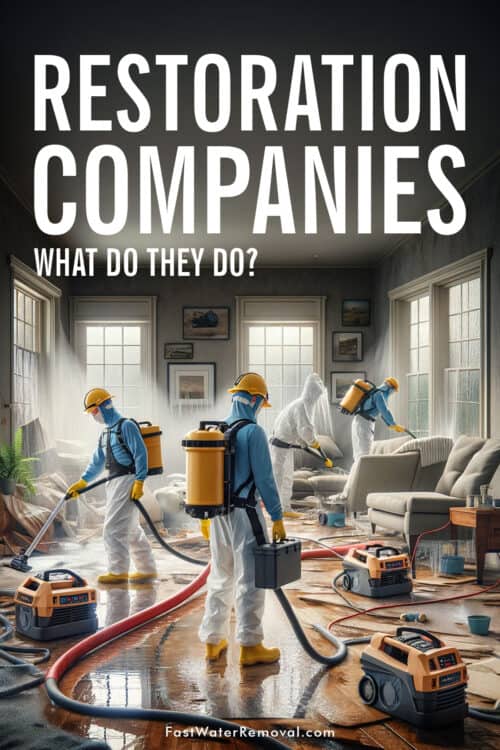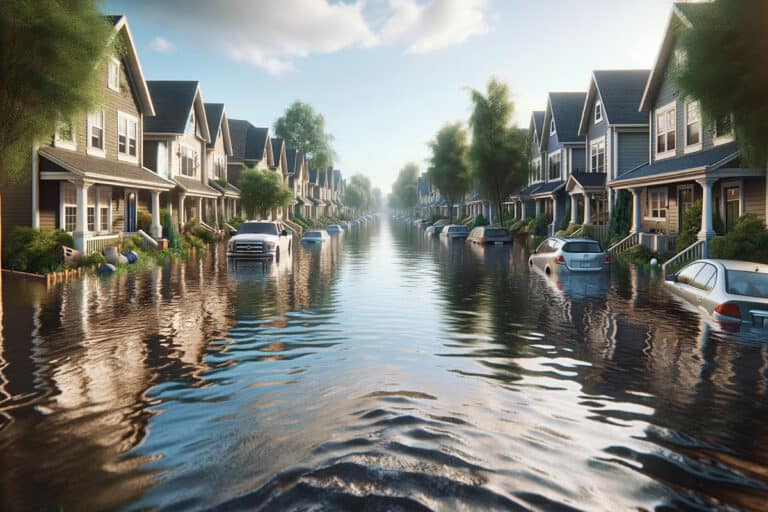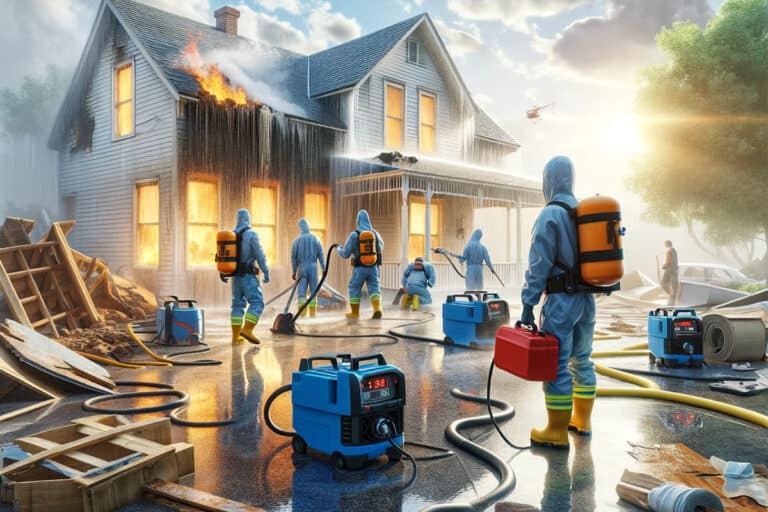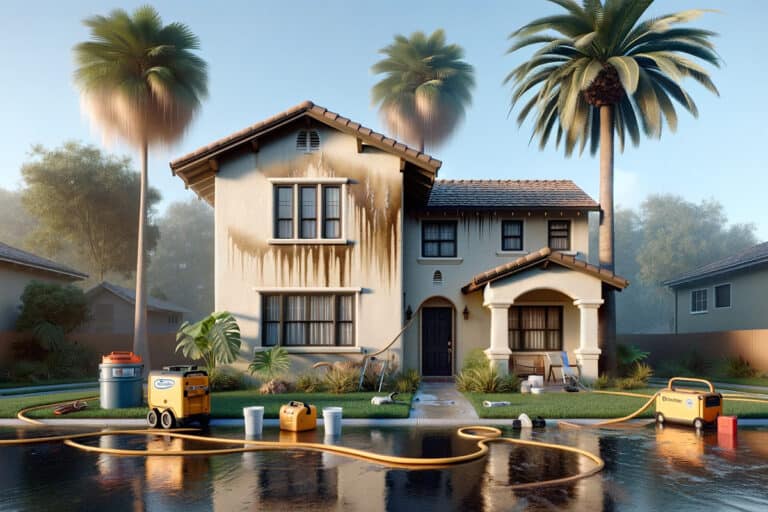Disclosure: I am compensated for purchases made through some links on this site. Click for details.
Restoration companies perform critical services after a disaster strikes a property, ensuring that homes and businesses are safe, clean, and ready for the necessary repairs. These specialized firms step in after incidents such as fires, floods, storms, and other catastrophic events that cause damage to structures. They work efficiently to mitigate further damage, safeguard structures from additional harm, and prepare the area for the rebuilding process.
The process undertaken by restoration companies typically begins with a thorough assessment of the damage. They are equipped to address various urgent problems, such as water damage that can lead to mold, structural weaknesses that may pose immediate risks, and destruction caused by fire and smoke. In collaboration with insurance companies, restoration professionals aim to restore properties to pre-disaster conditions, using specialized equipment and techniques tailored to each situation.
Key Takeaways
- Restoration companies manage the immediate aftermath of property damage.
- They prevent further damage and prepare for repair through a systematic approach.
- Collaboration with insurers ensures property restoration adheres to quality standards.
Overview of Restoration Companies
Restoration companies are specialized firms within the restoration industry that focus on remedying various types of property damage. These organizations employ professionals with expertise in restoring homes, businesses, and personal property to their pre-damaged states. They tackle a multitude of issues, ranging from water and fire damage to mold remediation and reconstruction.
The restoration process typically begins with an assessment of the damage, followed by the formulation of an action plan. Restoration services are comprehensive, often encompassing water extraction, dehumidification, sanitization, and repair of structural elements. The goal is to mitigate further damage while efficiently returning the property to a safe, livable condition.
As industry standards have evolved, restoration companies have adopted advanced techniques and equipment. They prioritize restoring a property swiftly, which is crucial in minimizing the interruption to daily lives or business operations. Trust in these professionals is paramount, as they possess the necessary training to handle various restoration scenarios responsibly and effectively.
Types of Damages Handled
Restoration companies are equipped to address a variety of damages that buildings might encounter through natural wear or unforeseen events. These damages can range from infiltrations of water to the aftereffects of a fire, including associated smoke damage.
Water Damage Restoration
Water damage can originate from flooding, plumbing leaks, or weather events, leading to structural issues or mold growth if not handled swiftly. Restoration companies provide water extraction, drying, and dehumidification to mitigate these effects. When dealing with water damage, sewage backup is also a potential concern, requiring specialized cleanup to ensure safety and sanitation.
Fire Damage Restoration
Fire damage involves not only the destruction caused by flames but also smoke damage and soot contamination. Companies focus on the recovery of fire-affected structures, employing techniques to cleanse smoke residue and repair the compromised property.
Mold Remediation
Exposure to mold can lead to health issues and substantial property damage. Restoration service providers often conduct mold assessments, execute thorough mold remediation processes, and take measures to prevent future mold growth in the affected areas.
Storm and Weather Event Restoration
Storm damage and destructive weather events often result in a combination of issues, including broken windows, compromised roofs, and water intrusion. Companies tackle these damages through emergency board-up services, property securing, and the repair of structures ravaged by natural disasters.
Initial Damage Assessment
When a property incurs damage, a restoration company conducts an initial damage assessment as the first crucial step in the restoration process. They meticulously examine the extent and type of damage to devise an appropriate plan for restoration services. Assessors often take photographs and compile detailed reports that are essential for insurance claims.
The damage assessment is typically comprehensive. It involves a thorough walkthrough to itemize affected areas and infrastructure. The assessors look for signs of water, fire, smoke, mold damage or other impacts from natural disasters.
Assessors use specialized equipment to detect hidden damage that isn’t visible to the naked eye. This equipment can pinpoint moisture within walls or soot deposits in ventilation systems. Insurance companies usually require this level of detail to understand the scope of work needed for restorations and reimbursements.
Property damage assessment is a step that directly influences the efficiency and success of subsequent restoration services. By accurately documenting damages, restoration companies can ensure they apply the correct techniques and resources to restore properties to their pre-damage condition. This stage is critical for working effectively with insurance providers and obtaining the necessary approval for restoration actions.
Restoration Steps
The restoration process involves precise and essential steps to ensure that properties damaged by events like water intrusion, fires, or natural disasters are efficiently restored to pre-damage condition. Proven methodologies are followed by professionals during the cleanup, repair, and finishing stages.
Cleanup and Removal
The initial phase involves thorough cleanup and removal of contaminated materials to prevent further damage. Restoration companies typically employ advanced techniques such as water extraction and dehumidification to dry out the affected areas. Items that are beyond repair are removed, while salvaged belongings may be cleaned and stored.
Repair and Reconstruction
Once the cleanup is complete, the focus shifts to repair and reconstruction. This step often requires structural repairs or rebuilding of damaged sections of the property. Tasks like replastering walls, replacing damaged woodwork, and ensuring the integrity of the building’s structure fall under this stage.
Finishing Touches
The final stage includes refinishing surfaces and applying the finishing touches. This may involve painting, flooring replacement, or restoration of details to match the property’s original state. Quality checks are conducted to ensure all repairs are completed to a high standard, resulting in a seamless restoration.
Handling Mold and Contaminants
When encountering mold in a home or business, restoration companies undertake a meticulous mold remediation process. This process involves several steps, beginning with a thorough inspection to identify the extent of the mold growth. They then proceed to containment, which is crucial to prevent the spread of mold spores to other areas during the cleanup phase.
Containment and Air Filtration
- Use of physical barriers
- Installation of HEPA air filters
- Negative air pressure to contain spores
The next phase typically includes air filtration using HEPA filters and establishing negative air pressure to ensure mold spores do not migrate. Restoration professionals will wear appropriate PPE to safeguard their health as they remove mold-infested materials. The affected materials are carefully bagged and disposed of following strict guidelines to avoid contamination.
Removal and Cleaning
- Infested material removal
- Cleaning and disinfecting areas
- HEPA vacuuming surfaces
They clean and disinfect all surfaces within the containment zone, often utilizing HEPA vacuums to capture even the smallest contaminants. In some cases, they treat areas to discourage future mold growth. Following remediation, comprehensive testing is performed to confirm that the mold has been effectively removed and that the environment is safe for occupancy.
Working with Insurance Companies
When a disaster strikes a property, restoration companies often collaborate closely with insurance companies to facilitate repairs and rebuilding efforts. These companies play a crucial role in the claims process, ensuring that the necessary work is covered financially and performed efficiently. Transparency between the restoration company and the insurance provider is key to ensuring that the property owner understands what services are covered and how claims are handled.
Emergency services are frequently required immediately after an incident, and restoration companies coordinate these initial steps to prevent further damage. This responsiveness helps speed up the approval of claims and begins the path to recovery. The restoration company typically contacts the insurance carrier to confirm the details of the coverage and to get an agreement on the scope and cost of the work outlined in the insurance policy.
A comprehensive insurance restoration job often includes detailed assessments of damage, documentation of losses, and negotiations with the insurance company to ensure a fair claims settlement. This process can be intricate, with restoration companies advocating on behalf of the property owner to cover the cost of all necessary repairs.
Ensuring Structural Integrity
Restoration companies specialize in returning a building’s structural soundness to its original state. They focus on identifying and fixing all aspects of a structure that compromise its stability and safety.
Structural Repairs
A critical aspect of maintaining a building’s structural integrity involves conducting thorough structural repairs. This includes replacing or reinforcing damaged beams, columns, and load-bearing walls. Restoration experts assess the building to determine the need for such repairs, which are instrumental in preventing the risk of structural failure.
Foundation and Supports
The foundation and supports are the bedrock of a building’s stability. Restoration efforts here involve fixing cracks, addressing soil settlement issues, and ensuring the foundation can bear the building’s weight. Companies offering foundation repair services perform evaluations and undertake necessary actions such as underpinning or pier installation to restore and maintain the integrity of these essential elements. Repair and maintenance in this area is crucial for long-term stability and safety.
Addressing Plumbing and Water Issues
In addressing water-related issues, restoration companies tackle immediate problems like burst pipes and persistent concerns such as standing water. The priority is to resolve plumbing issues to prevent further water damage.
Burst Pipes and Leaks
When burst pipes or leaks are detected, a restoration company acts swiftly to mitigate water damage. They identify the source of the plumbing issue and repair broken pipes to halt water flow. Prompt and precise intervention is crucial to prevent damage from spreading within the property.
Standing Water Removal
Removing standing water is a methodical process carried out by professionals using advanced equipment. Pumps and vacuums are employed to extract water quickly, minimizing moisture’s detrimental effects on the structure. This step is imperative to prevent mold growth and protect the integrity of the affected areas.
Rehabilitating Fire and Smoke Damage
Rehabilitating properties after a fire involves a meticulous process to address fire, smoke, and water damage. Companies specializing in fire restoration first assess the extent of the damage to lay out an action plan. They focus on salvaging as many items as possible while removing those that are beyond repair.
Smoke damage restoration is equally crucial because smoke can penetrate various surfaces leading to odors and potential health hazards. Restoration professionals use advanced cleaning techniques and equipment to remove soot and smoke residues. The goal is to restore air quality and prevent lingering smoke-related issues.
Tasks in fire damage restoration include:
- Evaluating structural integrity: Ensuring the building is safe for entry and restoration work.
- Water removal and drying: Addressing any water damage from firefighting efforts.
- Soot and debris cleaning: Eliminating residues from burned materials.
Items recoverable through specialized techniques include:
- Furniture: Cleaned with agents suitable for the material.
- Flooring: Restored or replaced depending on the type and degree of damage.
- Personal belongings: Assessed item by item for cleanability.
Companies dealing with fire cleanup and restoration ensure the property returns to a pre-loss condition. Whereas, the process of smoke restoration is integral to mitigating health hazards brought about by the fire. The multifaceted approach to restoration addresses both visible damage and less apparent but equally detrimental smoke infiltration.
Specialized Equipment and Techniques
Restoration companies employ a range of specialized equipment to tackle the complexities of property damage. High-speed fans, heaters, and moisture-detection tools are essential for drying and mitigating water damage. These instruments work cohesively to bring affected areas back to a safe and inhabitable condition.
The industry standards insist on the use of advanced technology, such as Rapid Structural Drying (RSD) systems that combine psychrometrics— the science of drying—with cutting-edge equipment. Remediation services also utilize air scrubbers and dehumidifiers to ensure the environment is free of contaminants and excess humidity. These practices are crucial for mold prevention and maintaining the structural integrity of a property.
Restoration companies are guided by established protocols to offer effective remediation services. They abide by those standards to ensure all restoration work is performed to the highest quality. The approach involves not only the removal of damaged materials but also the restoration of the property to its pre-damage state.
Final Inspections and Approvals
When restoration work nears completion, final inspections are essential to ensure the property has been restored to a safe and habitable condition. These inspections are conducted by qualified professionals who assess whether the restoration adheres to local building codes and industry standards. The process verifies that electrical systems, plumbing, construction, and finishing work are all completed properly, allowing for any necessary approvals or certificates of occupancy to be issued.
Approvals from the relevant authorities provide homeowners with peace of mind, knowing their restored property is safe to inhabit and has been refurbished to meet strict regulatory standards. Companies that specialize in restoration will often facilitate these approvals, interacting with inspectors and city officials on behalf of the homeowner. This coordination ensures compliance with all regulations and smooths the path toward officially closing out the project.
Once the final approvals are granted, a restoration company will conduct a comprehensive walkthrough with the homeowner. This walkthrough allows the homeowner to confirm that the work meets their expectations and that the living space is indeed habitable. It is also an opportunity to identify any outstanding punch list items, which need to be addressed before the final payment is released.
Cosmetic Repairs and Refinishing
Restoration companies often handle cosmetic repairs, which pertain to the enhancement of a structure’s appearance without significant structural changes. These repairs may include fixing scratches, dents, or other minor damage on surfaces like windows, doors, and cabinets. Such meticulous attention helps restore the visual appeal of these elements without the need for complete replacement.
Refinishing involves a more substantial transformation, the primary goal being to revitalize the surface appearance. For example, when tackling rust on metal fixtures or handling the delicate process of refinishing wooden furniture, restoration experts use specialized techniques. They meticulously strip old paint, sand down the surfaces, and apply new finishes to protect and enhance the aesthetic quality of the items.
This comparison highlights that while cosmetic repairs are more about minor touch-ups, refinishing is a comprehensive process that can significantly alter an item’s look and feel. Restoration professionals must have in-depth knowledge of materials and methods to ensure the longevity and beauty of the restored items.
Conclusion
Restoration companies are vital first responders for property damage emergencies. They specialize in repairing homes and businesses affected by water, fire, and natural disasters. Their services are comprehensive, ranging from water extraction to reconstruction, ensuring that damaged properties are restored to their pre-disaster condition.
Services provided by such companies often include assessment of damage, water removal, drying and dehumidification, cleaning, sanitizing, and restoration. Experts in this field deploy a variety of tools and technologies, following industry standards and protocols to prevent further damage. When choosing a restoration company, one should look for those offering 24/7 emergency service and with a reputation for quality and reliability.
The goal of a restoration company is not just to repair damages but to provide peace of mind to those affected. They take charge after unfortunate incidents to help clients navigate through the complexities of property restoration. These companies are valuable allies, dedicated to helping people rebound from the impacts of property damage quickly and effectively.





